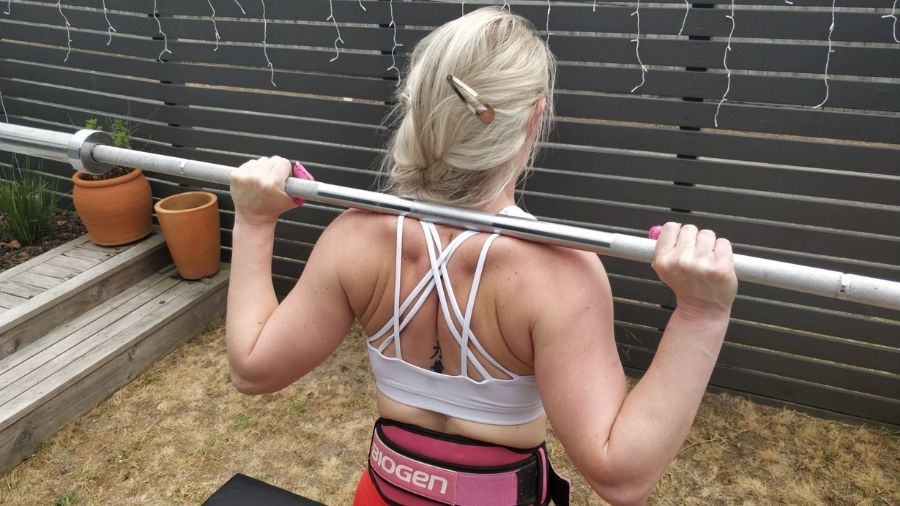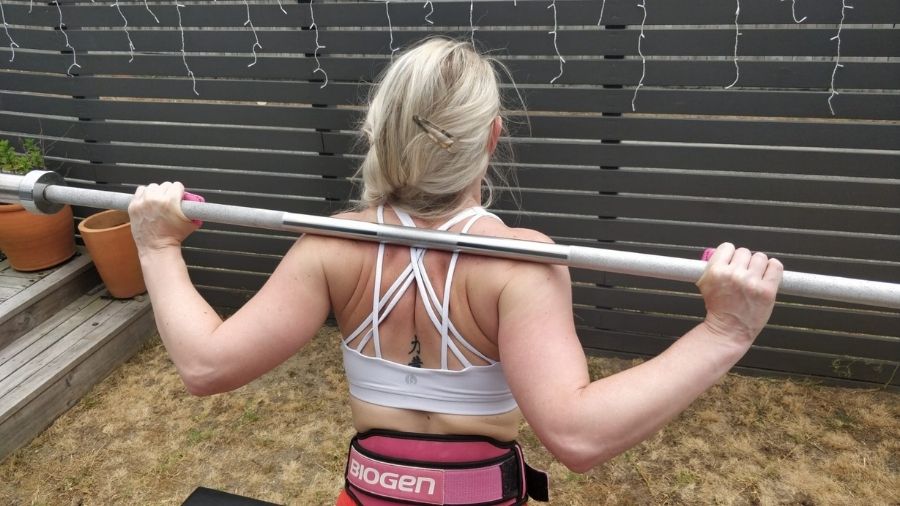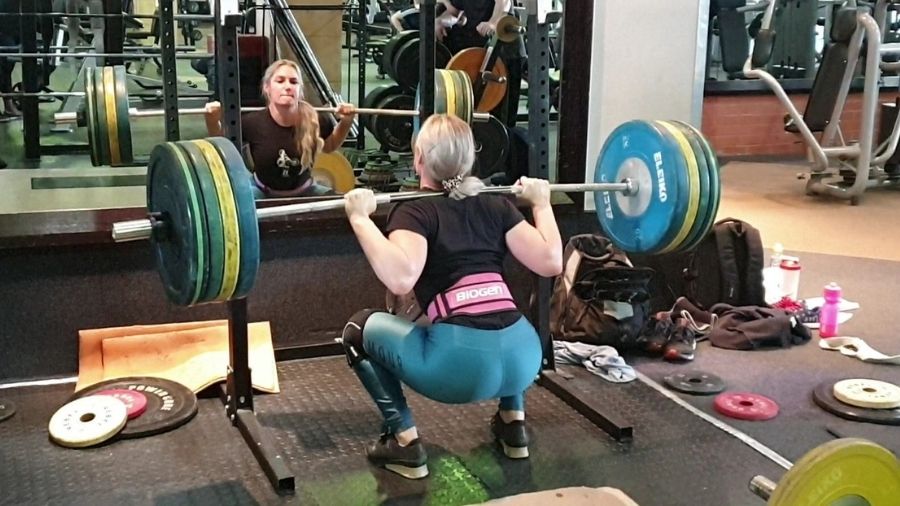It’s squat day—every bro’s favorite day of the week (leg day is everyone’s favorite, right?!). If you’re standing at the squat rack wondering if you’re going to low bar or high bar squat this session, I’ve got you covered.
The high bar squat is characterized by an upright torso and greater knee flexion, which places greater stress on the quads. The low bar squat has hip flexion and forward lean, targeting the glutes and lower back.
Does it make that much of a difference choosing the high or low bar squat when it comes to strength, size, and athletic performance?
Table of Contents
- High Bar vs. Low Bar Squats Muscles Worked
- High Bar vs. Low Bar Squats Ratio
- High Bar Squat Bar Position
- Low Bar Squat Position
- Is The High Bar or Low Bar Squat Better For Lower Back Pain?
- High Bar vs. Low Bar Squats For Hypertrophy
- High Bar vs. Low Bar Squats For Athletes
- High Bar vs. Low Bar Squats: Which Is Better?
High Bar vs. Low Bar Squats Muscles Worked
The high bar and low bar squat work the same muscles. That is, the quadriceps, glutes, erector spinae, and the hamstrings to some extent. However, the different bar placements result in varying muscle activity. For example, the high bar position tends to increase muscle activity of the rectus femoris and vastus medialis (two quadriceps muscles), and the lower back [1].
Whereas the low bar squat tends to increase the muscle activity of the glutes and hamstrings [2]. Interestingly, this study saw a more significant increase in lower back muscle activity with the low bar squat.
The differences may be due to the loads used where the first study used 5RM loads whereas the second study used up to 70% 1RM. Further, the first study didn’t show substantial differences in joint angles between squats, so the low bar squat was performed similarly to the high bar.
The second study used competitive Powerlifters and saw greater hip and knee angle changes in the bottom position, leading to slight differences in lower back muscle activity.
Overall, the low bar squat is characterized by greater hip flexion and, therefore, forward lean leading to greater glute and lower back muscle activity [3]. High bar squats involve greater knee flexion and a more upright torso leading to greater quadriceps muscle activation.
High Bar vs. Low Bar Squats Ratio
While there is no published research on the high bar vs. low bar ratio, it is often said that you can squat 5-10% more when low bar squatting. However, this will be individual. Suppose you are used to squatting using one variation. In that case, you will squat less using the other variation until you get used to it.
Squatting is a skill. This skill needs to be trained, which is why you will usually squat more with the variation you use most.
High Bar Squat Bar Position

The high bar squat has the bar placed across the top of the trapezius muscles. If you haven’t done this before, this can be painful. But stick with it. It won’t take long before you have no pain at all, and you’ll be handling hundreds of pounds on your traps.
Under no circumstances should you use a barbell pad. This creates instability and can be dangerous as loads get heavier. To keep the barbell tight on your traps, think about bending the barbell over your back.
Low Bar Squat Position

The low bar position is placed on the lower traps just over the rear deltoids (shoulders). This can require a fair amount of shoulder mobility to get into this position. If you are a competitive Powerlifter, this is the variation you will use most of the time.
If you are not a competitive Powerlifter, I would use the high bar squat over the low bar variation as it is more comfortable.
Is The High Bar or Low Bar Squat Better For Lower Back Pain?
Generally, the high bar squat is better for lower back pain as the low bar squat involves greater forward lean and lower back muscle activation [3]. However, both variations can aggravate the lower back, so not using the back squat at all may be warranted.
If you have a history of lower back pain, exclusively use the high bar squat as it will allow you to keep an upright torso. Sometimes using the front squat over the back squat is an even better option.
High Bar vs. Low Bar Squats For Hypertrophy
When squatting, lifters target hypertrophy (muscle growth) of the quadriceps and glutes. Both the high bar and low bar are good choices for lower body muscle growth. If you want to emphasize quad size, use the high bar variation.
If you want to emphasize glute growth, use the low bar variation. However, both the high and low bar will grow both muscle groups, so as long as you squat, your legs will grow.
When it comes to hamstrings, the squat is not a good choice. Ten weeks of either half or full squats increased glute and quadriceps size but not hamstrings size [4]. Train your hamstrings with specific hamstring exercises like leg curls and Romanian deadlifts.
High Bar vs. Low Bar Squats For Athletes

Athletic performance is not influenced by what squat variation you use. I would never make an athlete of mine high or low bar squat. I let them choose the variation they are most comfortable with. I can think of one athlete out of the hundreds I’ve worked with that squatted low bar in my time working in professional sport.
One thing to consider is that you can handle heavier loads with the low bar squat [5]. Since strength development is heavily influenced by intensity than any other programming parameter, the low bar squat may be a better alternative for maximum strength development [6].
High Bar vs. Low Bar Squats: Which Is Better?
There is no best option between high and low bar squats. If you are a competitive Powerlifter, you will use the low bar variation as your main squatting movement and the high bar as an accessory exercise to further build the strength of the quads.
Suppose you are a weekend warrior or someone training for athletic or aesthetic reasons. In that case, the high bar variation is the most comfortable, easiest to perform, and requires less shoulder mobility.
References
1. van den Tillaar, R., Knutli, T. R., & Larsen, S. (2020). The effects of barbell placement on kinematics and muscle activation around the sticking region in squats. Frontiers in Sports and Active Living, 2, 172.
2. Murawa, M., Fryzowicz, A., Kabacinski, J., Jurga, J., Gorwa, J., Galli, M., & Zago, M. (2020). Muscle activation varies between high-bar and low-bar back squat. PeerJ, 8, e9256.
3. Glassbrook, D. J., Helms, E. R., Brown, S. R., & Storey, A. G. (2017). A review of the biomechanical differences between the high-bar and low-bar back-squat. The Journal of Strength & Conditioning Research, 31(9), 2618-2634.
4. Kubo, K., Ikebukuro, T., & Yata, H. (2019). Effects of squat training with different depths on lower limb muscle volumes. European journal of applied physiology, 119(9), 1933-1942.
5. Glassbrook, D. J., Brown, S. R., Helms, E. R., Duncan, S., & Storey, A. G. (2019). The high-bar and low-bar back-squats: A biomechanical analysis. The Journal of Strength & Conditioning Research, 33, S1-S18.
6. Schoenfeld, B. J. (2010). The mechanisms of muscle hypertrophy and their application to resistance training. The Journal of Strength & Conditioning Research, 24(10), 2857-2872.
